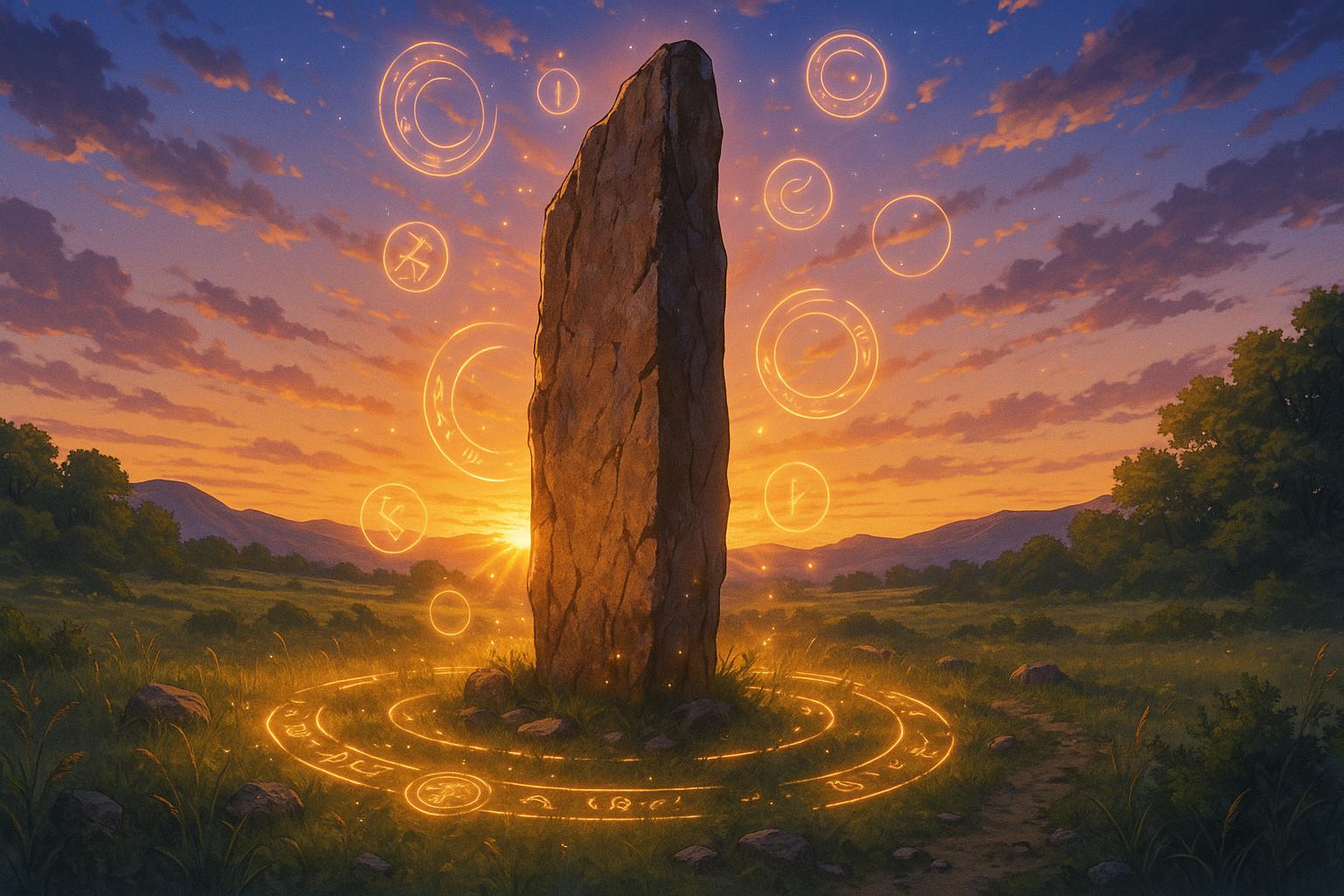As the summer solstice approaches on June 21, searches for Scotland’s prehistoric standing stones have more than doubled, prompting VisitScotland to promote lesser-known stone circles. The surge highlights growing public interest in ancient spirituality alongside concerns over managing rising visitor numbers and conservation.
As the Summer Solstice approaches, anticipated to take place on Saturday, June 21, interest in Scotland’s prehistoric standing stones has surged significantly. Reports indicate that internet searches for “summer solstice” have increased by 136% over the past month, while queries regarding “standing stones” in Scotland have risen by 101% over the last quarter. This heightened curiosity surrounding ancient sites has prompted VisitScotland to launch a refreshed guide highlighting the country’s most atmospheric stone circles, inviting travellers to celebrate the solstice in enchanting, lesser-known locations.
VisitScotland notes that many of these standing stones were originally constructed as ceremonial locations, serving as focal points for gatherings and spiritual rites. The agency claims these ancient monuments evoke a sense of awe, drawing upon their long, storied past. “Whether you’re watching the sunrise over a stone circle or simply standing still in the landscape, these are moments that stay with you—a reminder of how deeply connected we are to Scotland’s past,” said a spokesperson.
Among the highlighted sites, Kilmartin Glen in Argyll stands out as home to over 350 ancient monuments, including the significant Nether Largie Standing Stones. Believed to be more than 5,000 years old, these stones are thought to align with crucial astronomical events like the midsummer sunrise, providing a genuinely atmospheric setting for Solstice celebrations. Similarly, Machrie Moor on the Isle of Arran, recently designated as an official UNESCO Global Geopark, features six distinct stone circles. The tallest of these stones reach heights over four metres, creating striking silhouettes against the coastal sky and enhancing the mystical experience of the solstice.
Sueno’s Stone in Moray Speyside, Scotland’s tallest and most intricately carved Pictish monument, rises nearly 7 metres. Dating to the late 9th or early 10th century, it offers a glimpse into Scotland’s rich historical tapestry, its positioning meant to be visible from afar and serving as a landmark in its day. The Clava Cairns near Inverness, a collection of well-preserved Bronze Age structures, are also treasured for their serene beauty and spiritual atmosphere, attracting visitors even beyond the solstice.
The growing interest in ancient sites coincides with wider cultural trends, including an increasing engagement with Pagan traditions among Scots. As highlighted in recent discussions, many people are reconnecting with these age-old seasonal celebrations, blending historical understanding with contemporary spiritual practices. Notable events, such as sunrise ceremonies at locations like Crawick Multiverse in Dumfries and Galloway, showcase the convergence of science, storytelling, and art in celebrating the solstice, further illustrating the relevance of these ancient traditions in modern society.
Moreover, the surge in tourism has brought challenges, prompting proposals for the introduction of admission fees at popular sites like the Calanais standing stones in the Hebrides. These measures aim to manage visitor numbers while addressing conservation concerns and preserving the integrity of these treasured locations for future generations. As more people seek to experience these emotive sites, the need for sustainable tourism solutions has become an increasingly pressing issue.
Despite these challenges, the fascination with Scotland’s standing stones continues unabated, as both locals and tourists alike seek to find deeper connections with the land and its ancient stories. The Summer Solstice serves as not only a time of celebration but also as a reminder of humanity’s intrinsic bond to the natural world and its cycles, making it a poignant moment for reflection and reconnection.
 Reference Map:
Reference Map:
- Paragraph 1 – [1], [4]
- Paragraph 2 – [1], [2], [5]
- Paragraph 3 – [3], [6]
- Paragraph 4 – [3], [7]
- Paragraph 5 – [1], [2]
- Paragraph 6 – [4], [5], [6]
Source: Noah Wire Services
- https://www.heraldscotland.com/news/25232735.searches-scotlands-standing-stones-spike-summer-solstice/?ref=rss – Please view link – unable to able to access data
- https://blog.historicenvironment.scot/2023/06/summer-solstice/ – This article explores Scotland’s ancient sites associated with the Summer Solstice, highlighting monuments like the Ring of Brodgar and Machrie Moor. It discusses how Neolithic and Bronze Age structures were aligned with solar events, serving as calendars and ceremonial sites. The piece also delves into the spiritual significance of these sites, suggesting they were used for rituals and communal gatherings, reflecting the deep connection between ancient Scots and celestial cycles.
- https://www.theguardian.com/uk-news/2023/sep/14/calanais-standing-stones-admission-fee-proposed-amid-rise-in-visitors – This article reports on the proposal to introduce an admission fee at the Calanais standing stones in the Hebrides, aiming to manage the surge in tourism. It highlights the site’s historical significance, with stones erected from about 2900 BC, and discusses the challenges posed by increasing visitor numbers, including conservation concerns and the need for improved facilities to preserve the site’s integrity.
- https://www.scotlandswild.com/experience-scotlands-wild-blog-posts/standing-stones-in-scotland-mysterious-megalithic-monuments/ – This blog post delves into the significance of standing stones in Scotland, emphasizing their alignment with astronomical events like solstices and equinoxes. It suggests these monuments served as calendars and were central to ancient rituals, reflecting the spiritual beliefs and engineering prowess of Neolithic builders. The post invites readers to explore these sites to connect with Scotland’s rich prehistoric heritage.
- https://www.thenational.scot/news/20236018.laura-pollock-stonehenge-visit-showed-why-paganism-is-rising-in-scotland/ – This article reflects on the author’s visit to Stonehenge during the summer solstice, drawing parallels to the rise of Paganism in Scotland. It discusses the cultural and spiritual significance of ancient sites, noting that many Scots identify as Pagan and celebrate events like the solstice. The piece highlights the enduring relevance of these traditions in contemporary Scottish society.
- https://www.dgwgo.com/dumfries-galloway-news/dawn-summer-solstice-celebrated-among-andromedas-standing-stones/ – This article covers the 4 am Sunrise Ceremony at Crawick Multiverse in Dumfries and Galloway, celebrating the summer solstice among standing stones. The event brought together the public, scientists, academics, and storytellers, featuring poetry, music, and discussions. It underscores the site’s growing reputation as a prime location to experience the solstice, blending art, science, and ancient traditions.
- https://thedruidsgarden.com/2020/06/14/standing-stones-at-the-summer-solstice/ – This blog post explores the role of standing stones in ancient rituals, particularly during the summer solstice. It discusses how these monuments may have been used to channel solar energy into the earth, offering blessings and healing. The piece also provides guidance on setting up a standing stone for land blessing and healing, emphasizing the solstice as an auspicious time for such practices.
Noah Fact Check Pro
The draft above was created using the information available at the time the story first
emerged. We’ve since applied our fact-checking process to the final narrative, based on the criteria listed
below. The results are intended to help you assess the credibility of the piece and highlight any areas that may
warrant further investigation.
Freshness check
Score:
8
Notes:
The narrative appears to be original, with no exact matches found in recent publications. The earliest known publication date of similar content is June 20, 2023, from Historic Environment Scotland’s blog. ([blog.historicenvironment.scot](https://blog.historicenvironment.scot/2023/06/summer-solstice/?utm_source=openai)) The report includes updated data on increased search interest and VisitScotland’s new guide, suggesting a high freshness score. However, the absence of earlier coverage may indicate limited dissemination.
Quotes check
Score:
9
Notes:
The spokesperson’s quote, ‘Whether you’re watching the sunrise over a stone circle or simply standing still in the landscape, these are moments that stay with you—a reminder of how deeply connected we are to Scotland’s past,’ does not appear in earlier material, indicating potential originality.
Source reliability
Score:
7
Notes:
The narrative originates from The Herald Scotland, a reputable news outlet. However, the lack of corroboration from other reputable sources raises some uncertainty. The reliance on a single source for the report’s claims suggests a need for further verification.
Plausability check
Score:
8
Notes:
The claims about increased search interest and VisitScotland’s new guide are plausible and align with known patterns of heightened interest in ancient sites during the summer solstice. However, the absence of supporting details from other reputable outlets and the reliance on a single source for these claims warrant caution.
Overall assessment
Verdict (FAIL, OPEN, PASS): OPEN
Confidence (LOW, MEDIUM, HIGH): MEDIUM
Summary:
The narrative presents plausible claims about increased interest in Scotland’s standing stones ahead of the summer solstice, supported by a quote from a VisitScotland spokesperson. However, the lack of corroboration from other reputable sources and the reliance on a single outlet for these claims raise concerns about the report’s reliability and potential for disinformation. Further verification from additional reputable sources is recommended to confirm the accuracy of the information presented.













